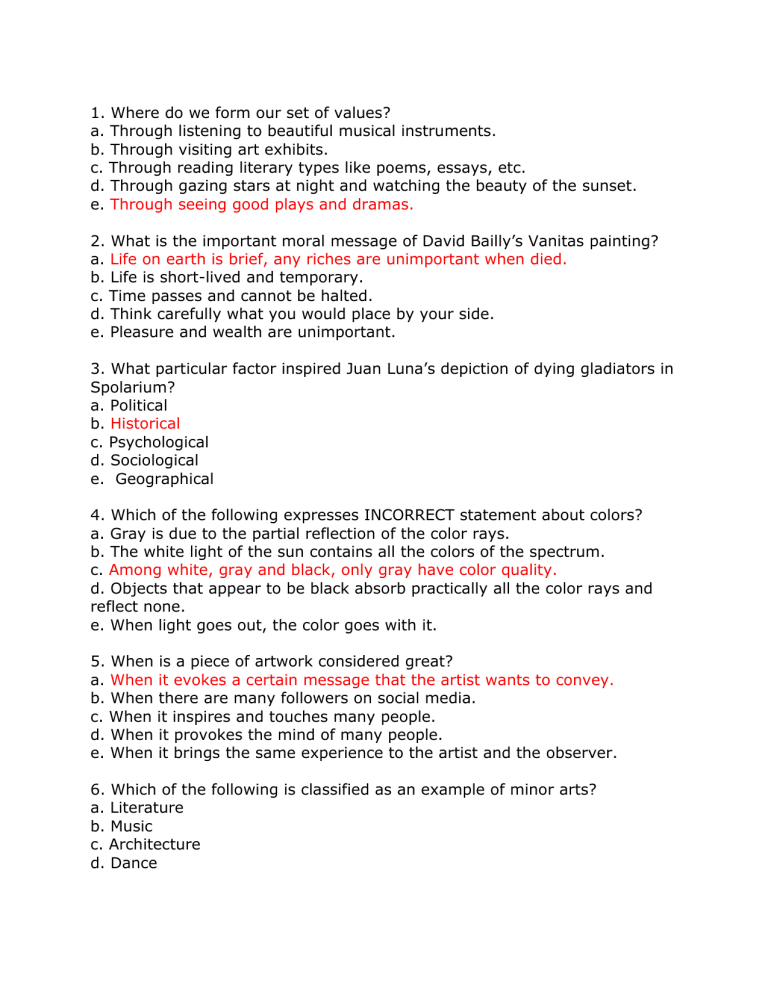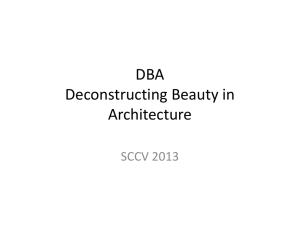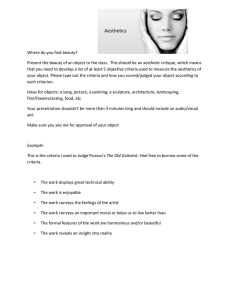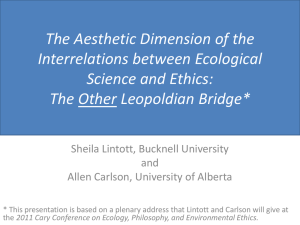
1. Where do we form our set of values? a. Through listening to beautiful musical instruments. b. Through visiting art exhibits. c. Through reading literary types like poems, essays, etc. d. Through gazing stars at night and watching the beauty of the sunset. e. Through seeing good plays and dramas. 2. What is the important moral message of David Bailly’s Vanitas painting? a. Life on earth is brief, any riches are unimportant when died. b. Life is short-lived and temporary. c. Time passes and cannot be halted. d. Think carefully what you would place by your side. e. Pleasure and wealth are unimportant. 3. What particular factor inspired Juan Luna’s depiction of dying gladiators in Spolarium? a. Political b. Historical c. Psychological d. Sociological e. Geographical 4. Which of the following expresses INCORRECT statement about colors? a. Gray is due to the partial reflection of the color rays. b. The white light of the sun contains all the colors of the spectrum. c. Among white, gray and black, only gray have color quality. d. Objects that appear to be black absorb practically all the color rays and reflect none. e. When light goes out, the color goes with it. 5. When is a piece of artwork considered great? a. When it evokes a certain message that the artist wants to convey. b. When there are many followers on social media. c. When it inspires and touches many people. d. When it provokes the mind of many people. e. When it brings the same experience to the artist and the observer. 6. Which of the following is classified as an example of minor arts? a. Literature b. Music c. Architecture d. Dance e. Film 7. What is beauty according to Dennis Dutton? a. It is the rich emotional lives of our most ancient ancestors. b. It is the beauty of music, the night sky and our descendants for as long as human race exists. c. It is our powerful reaction to images to the expression of emotions in art. d. All of the options mentioned. e. It is deep in our mind as a gift handed down from the intelligent skills of our ancient ancestors. 8. Associated with the Greek philosopher Protagoras, which quotation may be considered as an ancient reference to humanistic studies in the Western world? a. “The end justifies the means” b. “Man is the measure of all things” c. “Knowledge is virtue” d. “I think, therefore, I exist” e. “An unexamined life is not worth living” 9. What is the most basic relationship that the five areas of art: visual arts, music, dance, literature and drama are concerned with? a. Emotion b. Talent c. Artists d. Materials e. Skills 10. What aesthetic theory may be applied to the view that a woman with vital statistics of 36-24-36 is beautiful? a. Formalism b. Functionalism c. Idealism d. Hedonism e. Imitationalism 11. The following concepts about art are true EXCEPT___ a. Art is purely aesthetical. b. Art is universal and requires experience. c. Art involves skill and craftmanship. d. Art brings harmony and beauty in life. e. Art is a product of human expression. 12. What theory of art defines art as one that has didactic, political or therapeutic values? a. Functionalism b. Conventionalism c. Hedonism d. Formalism e. Idealism 13. As an art appreciation student, what reflects from the literary works of Rizal particularly Noli Me Tangere and El Filibusterismo? a. Rizal is no doubt a great literary master. b. Rizal’s ideas in his writings emanate from his personal experiences. c. Rizal besides being prolific writer is also multi-talented in all field of Arts. d. Noli and Fili contain characters which are both fictional and historical e. Rizal is truly a Filipino martyr, one of the reasons why he became our national hero 14. Why are the Paleolithic European cave paintings, native American wood carvings are not really art according to some experts? a. Because they have no value at all. b. Because they were ancient and difficult to decipher. c. Because they were made by people before the emergence of aesthetic experience. d. Because they were not sure made by humans . e. None of the options mentioned. 15. As an art appreciation student how would you express your point of view about Covid 19 Pandemic? a. Join rallies of cause-oriented groups. b. Create a painting about the Covid 19 Pandemic. c. Create a Covid 19 mural to public toilets’ walls. d. Talking to your local officials about your concerns. e. Make comments in the social media. 16. What are the three components of Art? a. Compassion, decisiveness and adaptability. b. Creativity, imagination and expression. c. Perseverance, valor and prudence. d. Passion, knowledge and truth. e. Resiliency, power and influence. 17. What do humanities emphasize? a. Appreciating one’s expertise in artworks. b. Appreciating expertise in artworks. c. Theories of art and its application. d. Making human, cultured and refined. e. The dignity and worthiness of a man. 18. Which of the following is NOT a principle of beauty based on Aesthetic Formalism? a. Simplicity b. Proportionality c. Order d. Integrity e. Utility 19. Which of the following DOES NOT explain why arts are called the humanities? a. Through arts, man strives to be good to be kind to others. b. Through arts, man strives to achieve ideals that create meaning for life. c. Through arts, man searches for the reality. d. Through arts, man gains more income. e. Through arts, man values and appreciates beautiful things. 20. Which statement explains the application of the aesthetic theory of hedonism in culinary art? a. The food is arranged neatly and orderly. b. The food is healthy and nutritious. c. The food uses only natural ingredients. d. The food tastes appetizing and delicious. e. The food is a native Filipino dish. 21. Which statement defines the content and method of learning in the humanities? a. The humanists learn about the natural phenomena in the world by observation. b. The humanists learn about the issues in their society by means of surveys and interviews. c. The humanities learn about themselves by reflecting on their nature and own experiences. d. The humanists learn about the ultimate reality of all things by aid of reasoning. e. The humanists learn about the meaning of life by faith and revelation. 22. Which of the following statements is contrary to the principles of transcreation? a. Transcreation does not require a translator with expertise in marketing. b. Transcreation minimizes the risk of brand erosion or miscommunication and preserves investment. c. Transcreation is a combination of discipline and art, translation and interpretation. d. Transcreation is paramount for a global marketing campaign. e. Transcreation is the process that re-evaluates the marketing material produced for a local market. 23. Which of the following functions of art uses new visual images to bring about political change? a. For commercialism. b. For communication. c. For entertainment. d. For psychological and healing purposes. e. The avant-garde. 24. Based on the video “Theories of Beauty” which of the following statement about beauty Dennis Dutton does not believe in? a. Beauty is deep in our minds. b. Beauty is in the eye of the beholder. c. Beauty is in the creation and enjoyment of works of art. d. Beauty is dynamic and evolutionary. e. Beauty is such an extremely complicated subject. 25. Which aesthetic theory agrees that the Sydney Opera house is beautiful because of its curvilinear shape like giant shells rising above the harbor? a. Cultural relativism b. Idealism c. Hedonism d. Formalism e. Functionalism 26. Which is NOT true about art? a. There is no superior or inferior art work. b. Creativity is a key factor to become an artist. c. Art is not nature, is one of the assumptions of art. d. Art promotes solidarity and understanding among people. e. To become an artist, it is important to study in an art school. 27. Ancient Greeks believed that the human body is the most beautiful figure to present as an art and this subject gave rise to the school of thought called nudism. Which of the following factors affects the artist to create a nude artwork? a. Historical Factor b. Sociological factor c. Psychological Factor d. Ideational Factor e. Technical Factor 28. What is the profound difference between fine arts and practical arts? a. Fine arts are for professionals while practical arts are too technical. b. Fine arts are purely aesthetic while fine arts are utilitarian. c. Fine arts are taught in colleges while practical arts are in vocational schools. d. Fine arts are classical while practical arts are modern. e. Fine arts are for adults while practical arts are for children 29. Which of the following is NOT one of the main points of modernist aesthetics? a. Works of art express these unusual ideas of artists. b. Art experience is detached from ordinary self-interested pursuits. c. Artists show us how to look at the world and how to understand ourselves d. Great works of art must be innovative and creative, expressing new ideas in new ways e. Aesthetic experience is utilitarian. 30. Which of the following is NOT an element of a visual art? a. Rhythm b. Colors c. Line d. Shape e. Texture




